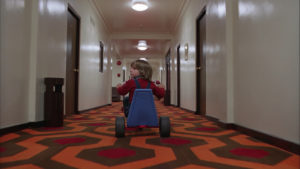
This scene from The Shining (1980, by Stanley Kubrick) cleverly utilizes the Steadicam to create an atmosphere of tension and unsettle the audience. Since we are following Danny as the camera, verisimilitude is created because we are immersed in the world of The Shining. The Steadicam is effective within this scene because it creates no noise, which ensures that we focus on the unbearable yet eerie whine of the Big Wheels’ which is vital in maintaining this level of tension which helps ensure verisimilitude. Since we are following Danny, we do not know what will happen next. Not only does this add to the tension, but also immerses us in the world; since we cannot physically see what is going to happen next. This helps to create atmosphere, since the audience will be on the edge of their seat and awaiting the next scene. This particular shot is significant to the narrative because it creates a slow, and deliberate heightened tension. Since most of the scenes within the film are typically long and drawn out, perhaps to add to this tension, the audience are always anticipating the next move. This shot shows this greatly because not only can we not physically see what will happen next, but the plot is slowed down to create more of an atmosphere
Danny is centralized, and surrounded by the corridors of the hotel. This suggests that the hotel is alive, because it is physically engulfing him. As this scene is played within the middle section of this film, we are shown the implication of Danny’s involvement with the hotel which can foreshadow his later near murder; which would lead to his implementation within the spirits of the hotel.
